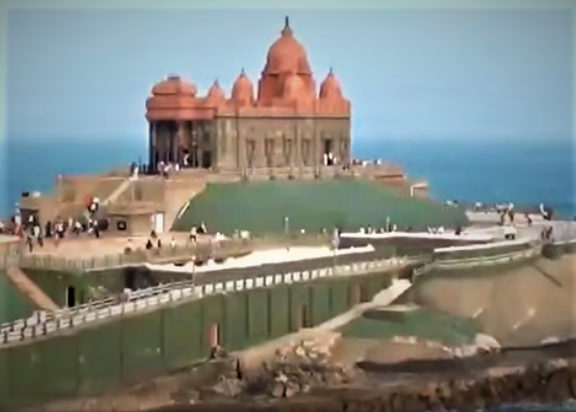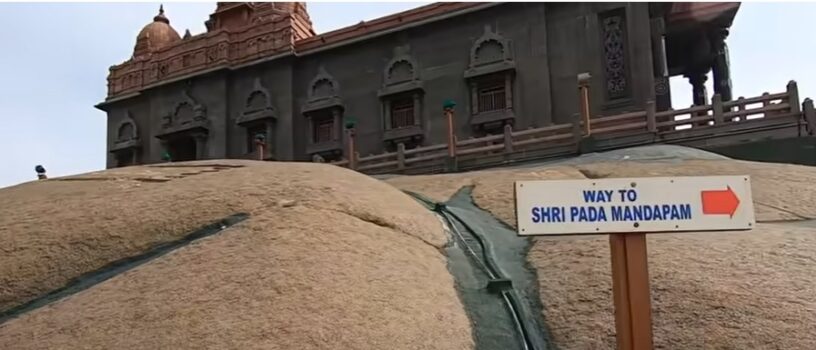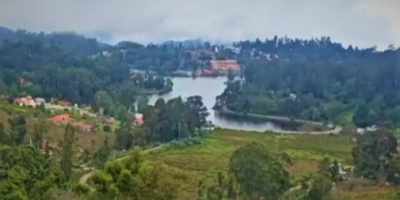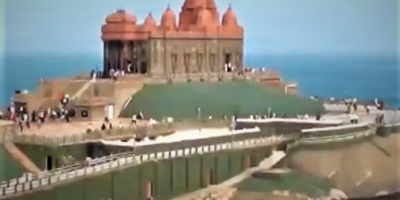Vivekanand Rock Memorial Kanyakumari, about 500 meters from the mainland end point of Kanyakumari in the Indian Ocean, is an underwater memorial to Swami Vivekananda which is one of the most famous tourist places in India. Vivekananda Memorial Kanyakumari is a wonderful example of natural beauty. This monument is also an unmatched attraction from historical and religious point of view. Vivekananda Memorial is also an example of modern architecture. If we call this a miracle then it would not be much!
Dedicated to the great saint, great orator, great scholar and patriot Swami Vivekananda, this rock memorial is built on the same rock where Swami Vivekananda himself had spent a few days and meditated.
Vivekanand Rock Memorial Kanyakumari in Hindi !
Vivekanand Rock Memorial Kanyakumari

Vivekanand Rock Memorial Kanyakumari was inaugurated in 1970. Actually, the first proposal for the construction of this memorial was made in 1962. After overcoming political and regional barriers, this amazing example of architecture was established as a memorial in 1970.
Swami Vivekanand – Vivekanand Rock Memorial Kanyakumari
Swami Vivekananda was born on 12 January 1863 in a Bengali family of Kolkata. His family was a prosperous family of Kolkata and he was the eldest among his nine siblings. His name in childhood was Narendra Dutt. Narendra Dutt was talented and logical since childhood. It was not acceptable for him to accept social rules as they were. He wanted to know the logic behind every social rule and if it was not there, he would not accept it.
Narendra Dutt was very intelligent in studies and had good interest in philosophy and scriptures. The college professor and principal liked him very much. Earlier, the ideas of Raja Ram Mohan Roy had a significant influence on Narendra Dutt and that is why he also followed Brahmo Samaj but after meeting Swami Ramakrishna Paramhansa, his views changed and he became his follower. Then his name also changed from Narendradatt to Vivekanand.
In the year 1881-82, he met Swami Ramakrishna Paramahamsa for the first time. After the death of Swami Ramakrishna, his disciples established Ramakrishna Math in which Swami Vivekananda also played a major role.
He continued touring India from 1888 to 1892. During this time he tried to understand India’s diversity and religious beliefs. In those days he had only a kamandalu and a stick. He also kept a copy of Srimad Bhagavad Geeta with him. He also kept a book named “The Limitation of Christ” with him. During the same tour he also went to Uttarkashi.
In 1893 he started going on foreign tours. First he went to Japan. The speech given by Swami Vivekanand at the All Religion Conference held in Chicago in September 1893 established him as an immortal saint in the world.
After coming to India, in 1897 he established Ramakrishna Mission in Kolkata.
Swami Vivekanand took Mahasamadhi on 4th July 1902.
History – Vivekanand Rock Memorial Kanyakumari
Swami Vivekanand came to Kanyakumari in December 1892 during his visit to India. After coming to Kanyakumari, he sat on this rock to meditate and stayed here for a few days.
The idea for the memorial was conceived in 1962 to commemorate the birth centenary of Swami Vivekanand, who is believed to have meditated on this rock in December 1892 before embarking on his historic journey to the West. During this meditation, Vivekanand is said to have attained enlightenment and a clear vision of his life’s mission—to inspire people to work towards the revival of India’s spirituality and social progress. The location was chosen as it is where the three seas—the Arabian Sea, the Bay of Bengal, and the Indian Ocean—meet, symbolizing the confluence of cultures, faiths, and thoughts.
The construction of the memorial, however, faced several challenges, including financial constraints and opposition from various political groups. The project was spearheaded by Eknath Ranade, a devoted disciple of Swami Vivekananda and a prominent figure of the Rashtriya Swayamsevak Sangh (RSS). With his leadership and dedication, funds were raised from all over India through donations from citizens, each contributing a symbolic one rupee, making it a truly people-powered project. Despite the initial hurdles, the construction began in 1964 and was completed in 1970. The memorial was built in a blend of traditional Indian architectural styles, incorporating elements from the Ajanta and Ellora cave temples, and was inaugurated on September 2, 1970, by the then President of India, V.V. Giri.
The Vivekanand Rock Memorial Kanyakumari stands as a symbol of unity, national pride, and spiritual awakening. The memorial consists of two main structures: the Vivekananda Mandapam, where visitors can meditate, and the Shripada Mandapam, a shrine that marks the spot where it is believed the footprint of Goddess Kanyakumari is imprinted on the rock. Surrounded by the pristine waters of the Indian Ocean, the memorial offers a stunning panoramic view and a tranquil atmosphere, making it a major tourist attraction and a place of pilgrimage. Today, it continues to inspire countless visitors by reminding them of Swami Vivekananda’s message of selfless service, spiritual upliftment, and national unity.
Kanyakumari also has religious fame because of the temple of Goddess Kumari. The Devi Kumari temple situated here is a Shaktipeeth. This city was called Kanyakumari after the name of Goddess Kumari. According to mythological stories, Goddess Kumari had purified and blessed this rock by touching it with her feet.
Architecture – Vivekanand Rock Memorial Kanyakumari
Vivekanand Rock Memorial, Kanyakumari is a blend of modern and traditional architecture. A glimpse of the Ramakrishna Mission Ashram in Belur, established by Swami Vivekananda, can also be seen in this architecture. The elephant sculptures installed at the entrance of this memorial give the feel of Ajanta Ellora.
The life-size bronze statue of Swami Vivekananda in the transition posture has been created by renowned sculptor Sitaram S.
Vivekananda Memorial Kanyakumari has two main mandapas. Vivekananda Mandapam and Sripada Mandapam. Dhyana Mandapam, Mukha Mandapam and Sabha Mandapam are located in Vivekananda Mandapam. Tourists coming here can also sit for meditation in Dhyana Mandapam if they wish. Sabha Mandapam is an assembly hall.
The construction of this memorial took the efforts of 650 workers and about 6 years.

Eknath Ramkrishna Ranadey – Vivekanand Rock Memorial Kanyakumari
Eknath Ranade was a dedicated social reformer, nationalist, and spiritual leader best known for his pivotal role in the creation of the Vivekananda Rock Memorial at Kanyakumari. Born in 1914 in Maharashtra, Ranade was deeply influenced by the teachings of Swami Vivekananda from a young age and became a lifelong devotee of his ideals. He joined the Rashtriya Swayamsevak Sangh (RSS) in his youth and rose through its ranks due to his organizational skills and commitment to national service.
Ranade’s most notable achievement was his leadership in the construction of the Vivekananda Rock Memorial in the 1960s. Despite facing financial and political obstacles, he mobilized support from people across India, emphasizing the importance of unity and spirituality. His efforts turned the memorial into a people’s project, funded by millions of small contributions. Ranade’s vision and perseverance not only ensured the completion of the memorial but also made it a symbol of India’s rich spiritual heritage and Swami Vivekananda’s enduring legacy. He later established the Vivekananda Kendra, a service mission dedicated to spreading Vivekananda’s message of selflessness, character-building, and national integration. Ranade’s life was a testament to selfless dedication and the power of a single individual to galvanize an entire nation toward a common cause.
Ticket – Vivekanand Rock Memorial Kanyakumari
Vivekananda Rock Memorial Kanyakumari is open for tourists from 8 am to 4 pm. To reach here one can come from the shore only by boat. Boat service to reach the memorial starts from 7 am. For this, you can buy a ticket of Rs 50 from the ticket window here. Morning is the best time to visit the memorial. Often a large number of people come here during the tourist season. In such a situation, to avoid the crowd, you can also go by taking a special ticket of Rs 200 for the boat.
On reaching Vivekananda Rock Memorial, you can buy a ticket of Rs 20 from the gate itself and go inside towards Mandapam.
How to reach – Vivekanand Rock Memorial Kanyakumari
By Flight to Vivekanand Rock Memorial Kanyakumari
If you are coming here by flight, then keep in mind that the nearest airport to Kanyakumari is Trivandrum Airport in Kerala. The distance from Trivandrum to Kanyakumari is approximately 90 kilometers. To reach Kanyakumari from Trivandrum, one can travel by car, bus or train. After reaching Kanyakumari, you can take local transport bus or auto to reach the point from where you can take a boat to Vivekananda Rock Memorial.
By Train to Vivekanand Rock Memorial Kanyakumari
Kanyakumari is the last station in the south of India and this city is connected by train to all the major cities of the country. Trains to Kanyakumari are directly available from major stations like Delhi, Mumbai, Hyderabad, Kolkata and Chennai.
By Road to Vivekanand Rock Memorial Kanyakumari
Kanyakumari is well connected by road network and can be easily reached by car or taxi.




Leave a Reply